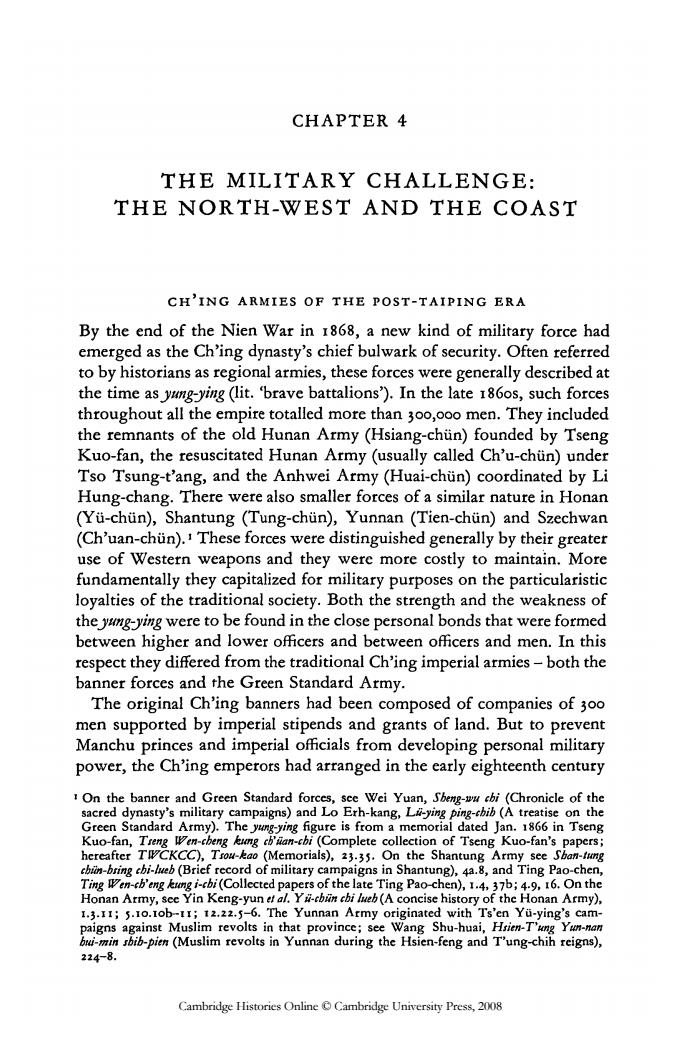正在加载图片...

CHAPTER 4 THE MILITARY CHALLENGE: THE NORTH-WEST AND THE COAST CH'ING ARMIES OF THE POST-TAIPING ERA By the end of the Nien War in 1868,a new kind of military force had emerged as the Ch'ing dynasty's chief bulwark of security.Often referred to by historians as regional armies,these forces were generally described at the time as yung-ying (lit.brave battalions').In the late 186os,such forces throughout all the empire totalled more than 3o0,oo0 men.They included the remnants of the old Hunan Army (Hsiang-chuin)founded by Tseng Kuo-fan,the resuscitated Hunan Army(usually called Ch'u-chun)under Tso Tsung-t'ang,and the Anhwei Army (Huai-chun)coordinated by Li Hung-chang.There were also smaller forces of a similar nature in Honan (Yu-chun),Shantung (Tung-chun),Yunnan (Tien-chun)and Szechwan (Ch'uan-chun).1 These forces were distinguished generally by their greater use of Western weapons and they were more costly to maintain.More fundamentally they capitalized for military purposes on the particularistic loyalties of the traditional society.Both the strength and the weakness of the ygying were to be found in the close personal bonds that were formed between higher and lower officers and between officers and men.In this respect they differed from the traditional Ch'ing imperial armies-both the banner forces and the Green Standard Army. The original Ch'ing banners had been composed of companies of 3oo men supported by imperial stipends and grants of land.But to prevent Manchu princes and imperial officials from developing personal military power,the Ch'ing emperors had arranged in the early eighteenth century On the banner and Green Standard forces,see Wei Yuan,Sheng-ws cbi(Chronicle of the sacred dynasty's military campaigns)and Lo Erh-kang,Liying ping-chib(A treatise on the Green Standard Army).The yung-ying figure is from a memorial dated Jan.1866 in Tseng Kuo-fan,Treng Wen-cbeng erng cb'an-cbi (Complete collection of Tseng Kuo-fan's papers; hereafter TCKCC),Trou-ao (Memorials),23.35.On the Shantung Army see Sban-fuong chiin-bring cbi-lueb (Brief record of military campaigns in Shantung),4a.8,and Ting Pao-chen, Ting Wen-cb'eng erng i-cbi(Collected papers of the late Ting Pao-chen),1.4,37b;4.9,16.On the Honan Army,see Yin Keng-yun et al.Yi-cbiin cbi lueh (A concise history of the Honan Army), 1.3.11;5.10.IobI;12.22.5-6.The Yunnan Army originated with Ts'en Yu-ying's cam- paigns against Muslim revolts in that province;see Wang Shu-huai,Hsien-T'ang Yaon-man bui-min sbib-pien (Muslim revolts in Yunnan during the Hsien-feng and T'ung-chih reigns), 224-8. Cambridge Histories Online O Cambridge University Press,2008CHAPTER 4 THE MILITARY CHALLENGE: THE NORTH-WEST AND THE COAST CH'IN G ARMIES OF THE POST-TAIPING ERA By the end of the Nien War in 1868, a new kind of military force had emerged as the Ch'ing dynasty's chief bulwark of security. Often referred to by historians as regional armies, these forces were generally described at the time n&yung-ying (lit. 'brave battalions'). In the late 1860s, such forces throughout all the empire totalled more than 300,000 men. They included the remnants of the old Hunan Army (Hsiang-chiin) founded by Tseng Kuo-fan, the resuscitated Hunan Army (usually called Ch'u-chiin) under Tso Tsung-t'ang, and the Anhwei Army (Huai-chiin) coordinated by Li Hung-chang. There were also smaller forces of a similar nature in Honan (Yii-chun), Shantung (Tung-chun), Yunnan (Tien-chun) and Szechwan (Ch'uan-chiin). > These forces were distinguished generally by their greater use of Western weapons and they were more costly to maintain. More fundamentally they capitalized for military purposes on the particularistic loyalties of the traditional society. Both the strength and the weakness of thejuftg-ji/jg were to be found in the close personal bonds that were formed between higher and lower officers and between officers and men. In this respect they differed from the traditional Ch'ing imperial armies - both the banner forces and rhe Green Standard Army. The original Ch'ing banners had been composed of companies of 300 men supported by imperial stipends and grants of land. But to prevent Manchu princes and imperial officials from developing personal military power, the Ch'ing emperors had arranged in the early eighteenth century 1 On the banner and Green Standard forces, see Wei Yuan, Sbeng-wu cbi (Chronicle of the sacred dynasty's military campaigns) and Lo Erh-kang, h.u-ying ping-chih (A treatise on the Green Standard Army). The yung-ying figure is from a memorial dated Jan. 1866 in Tseng Kuo-fan, Tseng Wen-cbeng kung cVuan-chi (Complete collection of Tseng Kuo-fan's papers; hereafter TWCKCC), Tsou-kao (Memorials), 25.3$. On the Shantung Army see Sban-tung cbiin-bting ehi-lueb (Brief record of military campaigns in Shantung), 4a. 8, and Ting Pao-chen, Ting U^en-cb'eng Mung i-cbi(Collected papers of the late Ting Pao-chen), 1.4, 37b; 4.9, 16. On the Honan Army, see Yin Keng-yun el al. Yii-cbun chi lueh (A concise history of the Honan Army), I.J.II; j.io.iob-n; 12.22.5-6. The Yunnan Army originated with Ts'en Yii-ying's cam- paigns against Muslim revolts in that province; see Wang Shu-huai, Hsien-T'ung Yun-nan bui-min sbib-pitn (Muslim revolts in Yunnan during the Hsien-feng and T'ung-chih reigns), 224-8. Cambridge Histories Online © Cambridge University Press, 2008